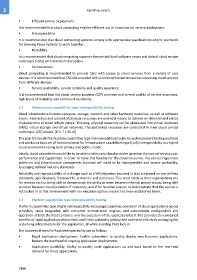Page 1460 - 5G Basics - Core Network Aspects
P. 1460
3 Signalling aspects
• Efficient service deployment
It is recommended that cloud computing enables efficient use of resources for service deployment.
• Interoperability
It is recommended that cloud computing systems comply with appropriate specifications and/or standards
for allowing these systems to work together.
• Portability
It is recommended that cloud computing supports the portability of software assets and data of cloud service
customers (CSCs) with minimum disruption.
• Service access
Cloud computing is recommended to provide CSCs with access to cloud services from a variety of user
devices. It is recommended that CSCs be provided with a consistent experience when accessing cloud services
from different devices.
• Service availability, service reliability and quality assurance
It is recommended that the cloud service provider (CSP) provides end-to-end quality of service assurance,
high levels of reliability and continued availability.
5.2 Infrastructure capabilities type interoperability testing
Cloud infrastructure includes compute, storage, network and other hardware resources, as well as software
assets. Abstraction and control of physical resources are essential means to achieve on-demand and elastic
characteristics of cloud infrastructure. This way, physical resources can be abstracted into virtual machines
(VMs), virtual storage and virtual networks. The abstracted resources are controlled to meet cloud service
customers' (CSC) needs. [ITU-T Y.3510]
The goal for cloud infrastructure capabilities type interoperability is to devise and implement testing methods
and conduct a basic set of functional tests for infrastructure capabilities type (IaaS) Interoperability in a hybrid
cloud environment using both private and public clouds.
Ideally, cloud subscribers would like to be able to select any cloud provider based on the basis of service cost,
performance and capabilities. In order to make this feasible for the cloud consumer, the various hypervisor
platforms and infrastructure components involved will need to be interoperable and enable portability,
leveraging defined industry standards.
Reliability and reproducibility of a change such as a VM migration involved in IaaS are based on pre-defined
standards, specifications, frameworks, scenarios, and processes. This need exists in their organizations too
for reasons such as being able to demonstrate the ability to move between internal private clouds, being able
to move between cloud providers if necessary, and if for no other reason, to demonstrate that the service is
not locked in to that environment with no relocation options once it has been established there.
5.3 Platform capabilities type interoperability testing
Platform capabilities type (PaaS) interoperability encourages seamless operation of cloud applications across
providers, rapid integration with consumer orchestration engines, and automatable configuration and
operation of both the PaaS container and the execution of the application itself. This provides the combined
benefits of rapid application deployment and linear scalability without the overhead of directly managing the
underlying infrastructure for the application, all while avoiding PaaS lock-in.
The business drivers for PaaS Interoperability are as follows:
• Rapid application deployment: Enable subscribers to quickly deploy new business applications.
Reduce the overhead of ongoing application deployments.
• Application scalability: Ability to quickly scale applications up and back based on the real-time
demand for those applications.
1450

